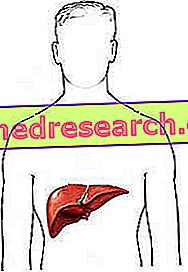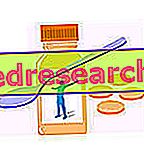Liver disease is a fairly common symptom, although diagnostic investigations very often contradict the hepatic origin of the problem. The patient, in fact, normally speaks of a bad liver in the presence of a localized pain in the upper right abdominal region, known for the anatomical correspondence to the organ site (see figure).
Pain in the liver and biliary tract
Most painful liver crises can be traced to biliary tract problems (calculants obstructing the ducts, acute or chronic cholecystitis, choledocytes, papillitis).

The increase in tension of the Glissonian capsule can be the consequence of inflammatory processes (hepatitis), but in general it causes pain only when it occurs abruptly. In chronic forms, responsible for slow and progressive increases in tension, pain is generally absent, unless the increase in volume of the organ is such as to affect the parietal peritoneum that surrounds it. This is why the liver disease caused by cirrhosis, chronic hepatitis and tumors usually appears only at an advanced stage of the disease. In addition to pain, these severe liver diseases are typically associated with jaundice, rapid and consistent weight loss, anorexia (lack of appetite), fatigue, nausea and vomiting. Therefore, if liver pain is associated with any of these symptoms it is important to undergo a medical examination as soon as possible.
A rather mild but continuous hepatic pain is typical of the so-called "fatty liver", better known as hepatic steatosis. Once again at the origin of the pain symptomatology there is the volumetric increase of the organ, this time caused by the excessive accumulation of fat inside it. Liver steatosis is characteristic of obese people and alcoholics; very often it is completely asymptomatic.
"Liver pain": extrahepatic origins
Pain experienced in the center-upper right region of the abdomen can be caused by several abnormal conditions in the extrahepatic site, such as: pancreatitis, pancreatic tumors, irritable bowel syndrome, gastritis, duodenitis and pyloric ulcers.
Liver pain and nutrition
The link between over-abundant meals and a feeling of heaviness in the center-upper right region of the abdomen is common to many people. This empirical relationship can be explained on the basis of various factors, even if everything is often minimized by attributing pain to the organ's intense digestive activity. In fact, as stated a few lines ago, the pain felt at the anatomic site of the organ has, most of the time, extrahepatic origins. Excessive gastric acidity, either due to predisposing individual factors, or due to stress or overeating, can for example ignite the walls of the first part of the duodenum, which looks at case anatomically localize at the hepatic hilum. Another possible cause of "liver pain" after meals is the intense contraction of the gall bladder, due to the presence of stones inside it or in the biliary tract, or due to excessive hormonal stimulation. Therefore, also because of other possible problems or due to the absence of an evident relationship between functional overload of the organ and hepatic pain, it is not easy to establish a direct link between the symptom and eating habits. To keep the organ healthy, it is advisable to moderate the consumption of alcohol, fries and foods that are particularly rich in fat, especially when cooked.
Bad liver and physical activity
During physical activity, a blood diversion is produced from the digestive system to the muscular system; the poor blood supply to the digestive organs can therefore accentuate liver pain associated with intra or extrahepatic factors.



